One of the best ways to add delicious perennial fruit to your landscape is to plant and grow a few blueberry bushes – not only is it easy to do, but it can pay off year after year with an amazing harvest of fresh berries for you and your family!
Sweet, delicious, and packed with tons of nutrients, blueberries are one of the healthiest super foods you can grow. The tiny blue spheres burst with flavor and are packed with antioxidants.
In fact, not only are they thought to be able to help prevent heart disease, they also are touted for lowering blood pressure and help to improve memory. If that wasn’t enough, they can also help with bone strength, blood pressure and diabetes management!
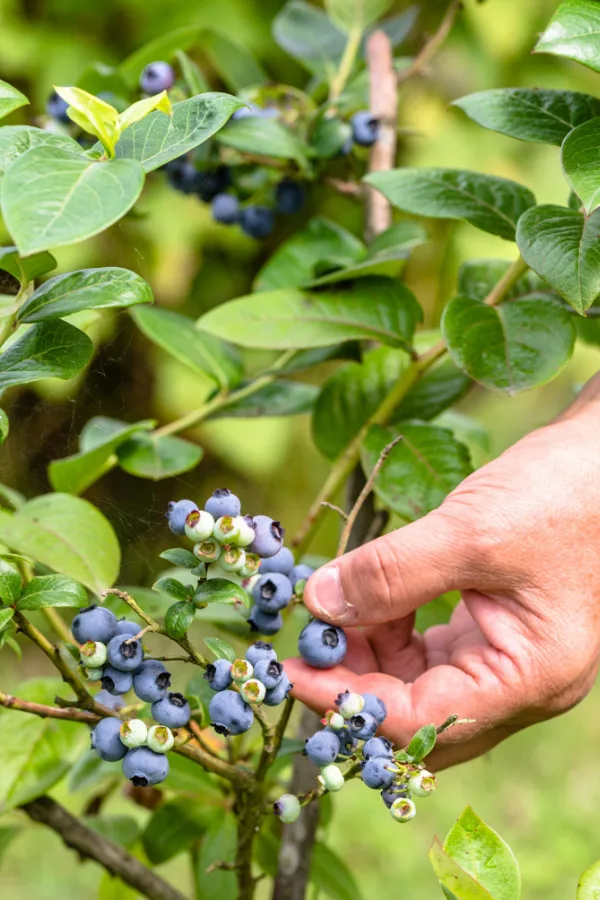
One thing thing is for sure, a single effort of planting can pay off with years of harvests. Blueberry bushes can grow and produce for a long time. How long? Some bushes can stay productive for up to 25 years or more!
Best of all, it doesn’t take a lot of bushes to grow a lot of fruit. Once mature, depending on the variety, a single bush can produce anywhere from several pounds to five pounds of fruit per year.
Low Care – Big Harvests! How To Plant Blueberry Bushes
Perhaps the biggest advantage of growing blueberries in your backyard is just how easy they are to maintain. Once established, blueberries only require minimal basic care while rewarding you with a bountiful harvest.
Last but not least, blueberry bushes add year-round beauty and interest to your landscape as well. With their bright green foliage, tiny blooms and big beautiful blue berries, they are a sight to behold in the spring, summer and fall. And to boot – their intricate branch structure even looks good in the middle of winter!
With all of those benefits in mind, here is a loot at the various types of blueberries you can plant, and how to put them in the ground to set the stage for growing success!
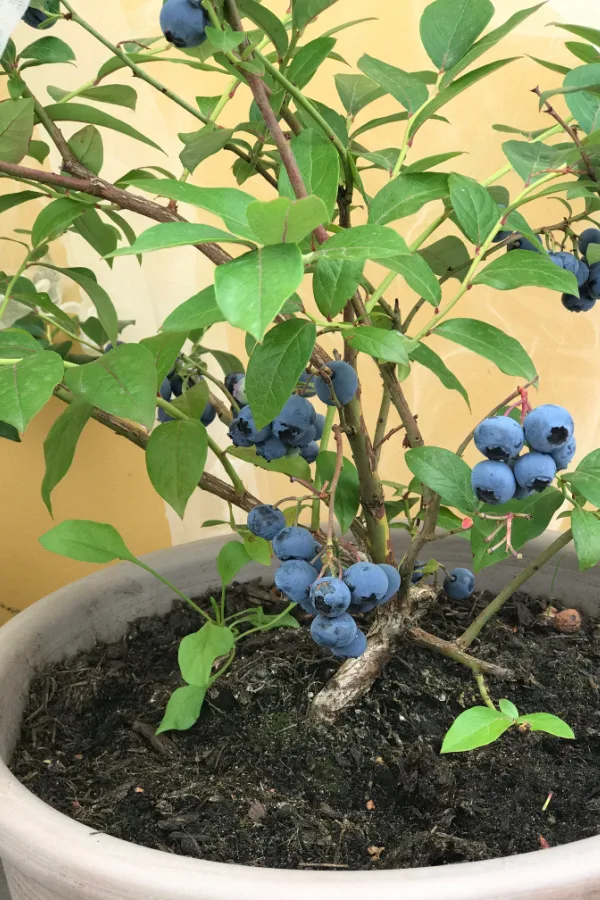
How To Plant Blueberry Bushes For Success
Varieties of Blueberry Bushes – How To Plant Blueberry Bushes
There are several different varieties of blueberry bushes available, but they come in four main types: highbush, lowbush, hybrid half-high, and rabbiteye. it is important to choose the type that will work best for your specific growing location and climate.
Highbush blueberries tend to be more disease resistant than other cultivators. They can grow in Zones 4 through 7 and can reach p to around six feet in height, depending on the specific variety. Most plants are self-fertile, but cross-pollination with another cultivator usually results in higher yields.
Lowbush blueberry varieties are smaller, with compact bush-like growth. Most only grow to around two feet tall. They are excellent for growing in containers, but are not self-fertile so you will need to at least plant two varieties. Lowbush do better in cooler climates and are hardy in Zones 3 through 7.
Hybrid half-high varieties are a combination of highbush and lowbush cultivators. They produce medium-sized plants that grow up to around four feet tall. Half-high’s do well in temperatures down close to freezing. They can also be used as container plants.

Lastly, rabbiteye blueberry varieties grow up to ten feet tall and require frequent pruning. They thrive in locations with warm summers (Zones 7 through 9) and will struggle in locations with cold winters. Like lowbush blueberries, rabbiteye plants are also not self-fertile and need a different cultivator of the same type in order to produce fruit.
Slow & Steady – How To Plant & Grow Blueberry Bushes
Blueberry plants grow slowly but take minimal effort to maintain. It takes a few years for plants to really become established and start producing large yields. However, the wait is definitely worth it in the long run!
You will start to see fairly good harvests within two to three years. Their maximum output starts around year five as long as a few basic needs are taken care of. Now let’s cover the specifics of planting and maintaining your blueberry bushes for maximum success!
Planting & Maintaining Blueberry Bushes
You can find blueberry plants at local nurseries or in on-line stores starting in early spring. Planting in early spring will give plants enough time to become established before the harsh summer heat. Just be sure to select varieties that are best for your growing zone and climate.
For quicker yields and better-growing results, purchase plants that are already two to three years old. They will come as either potted plants or bare-root plants; Both options are fine for planting. Selecting younger plants may be a bit cheaper, but can add one or two more years to getting sizable production.
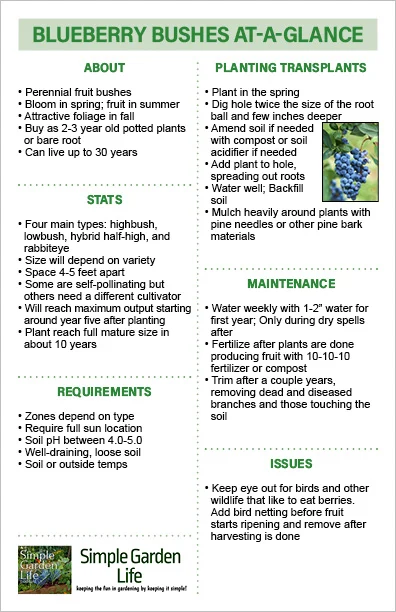
Choosing The Location & Soil Type
Pick a location that receives full sun and is out of harsh winds. Blueberry plants can tolerate some shade, but you will get higher yields in full-sun locations. For best results, make sure your blueberries will get at least 6 full hours of sunlight each day.
Choosing a location with the right type of soil is extremely important for blueberry bushes as well. The soil needs to be loose, well-draining, and contain plenty of organic matter. You also want to pick a location that has slightly acidic soil – or adding an acidifier to the soil to make it have a lower pH. Unfortunately, alkaline soil will stunt the growth of blueberry bushes.
One of the best ways to know what type of soil you are starting with is with an inexpensive soil PH meter. You simple put the probes in the ground and it will give you the soil’s pH. Aim for a soil pH of around 4.0 to 5.0. If it is higher, you can an acidifier to lower it. (Product Link: Soil pH Meter)
Since blueberry plants’ roots grow more horizontally as opposed to deep down into the soil, you should avoid planting them in locations with dense, clay-like soils that tend to retain too much moisture. Amend these types of soils or consider growing potted plants instead.
Planting – How To Plant & Grow Blueberry Bushes
Once you’ve found the perfect location, dig a hole that is twice the width of your plant and three to four inches deeper. This spacing will allow the roots of the blueberry bushes to really expand outward as opposed to growing deeper.
Now is the time to amend the soil if needed. Add any extra compost or soil acidifier if needed. Set the blueberry plant into the hole, fanning out the roots in all directions. Ensure that the root ball is just below the surface of the ground. Water the hole well before backfilling, allowing the moisture to really soak down into the roots and the soil. Once watered in, backfill with soil and lightly tamp down.
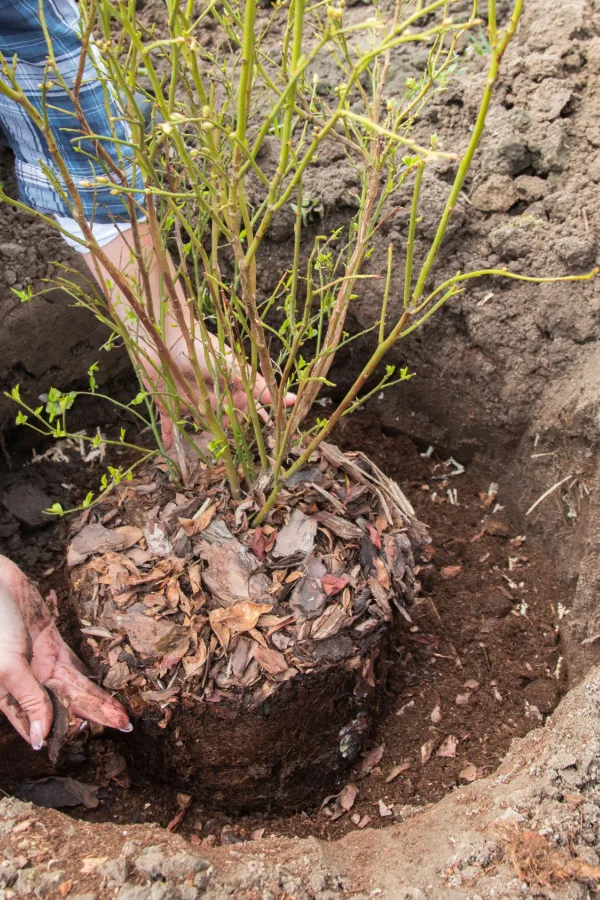
Space additional plants about four to five feet apart. This distance will vary, however, depending on which variety you are growing and their mature size. Most plants will not reach their mature size until after about 10 years of growth.
Adding Mulch
After planting, be sure to add several inches of organic mulch. Using more acidic materials like pine needles or pine bark, which are both excellent choices for blueberry bushes. As these materials break down, they will help to increase the acid levels of the soil.
Green needles are best, as they contain the most acid and will help release it into the soil. The mulch will help to prevent weeds from growing around the blueberry bushes as well as help to maintain moisture in the soil without waterlogging roots.
Long-Term Care – How To Plant, Grow & Maintain Blueberry Bushes
Watering
Blueberry bushes need around an inch to two inches of water or rainwater every week during the first year after planting. Once plants are two years or older, only water if you are experiencing long periods of drought.
Fertilizing
Blueberry bushes should be fertilized at three times during the year with a fertilizer geared towards acidic plants. Fertilize right before they come out in early spring, again four to six weeks later as they start to set blooms, and once more after they finish blooming.
This will keep plants strong and give you the best chance for a big harvest. Also – do not fertilize with compost as it can change the pH, resulting in less healthy plants.
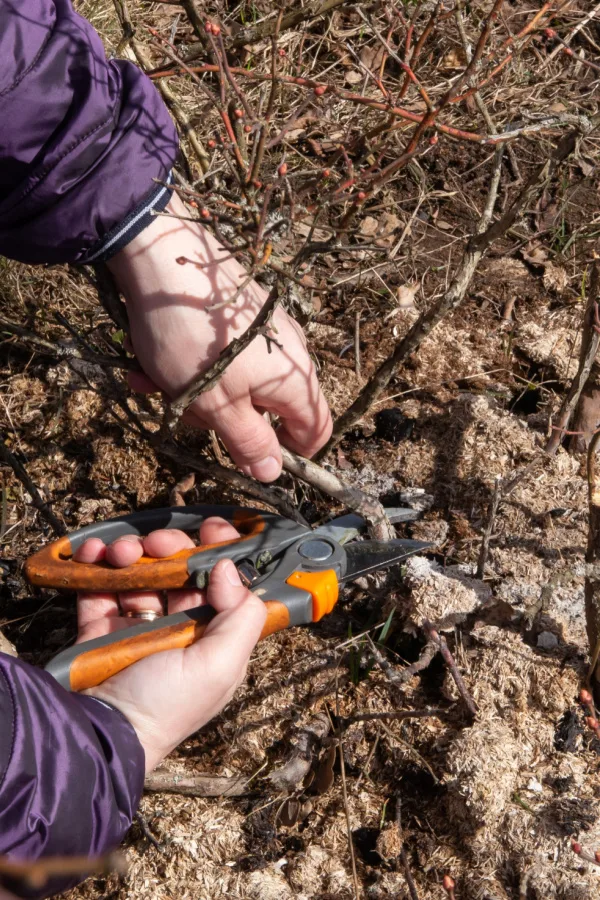
Pruning
You don’t need to prune your blueberry bushes in the first few years after planting. However, when it is time to prune, you should do so in late winter for most climates. You want to make sure that the blueberry bushes are completely dormant. For most locations, that will be in January or February.
Remove or trim any branches that are dead or diseased. You also want to make sure to prune any branches that are low to the ground or touching the soil. You can also prune the canopy to shape.
Birds & Wildlife – How To Plant & Grow Blueberry Bushes
While blueberry bushes are often left alone by most pests, they are loved by birds and some wildlife. In fact, blueberries don’t even need to be ripe in order for the birds to decimate an entire crop in a short period of time.
To help protect your blueberry bushes from birds and other hungry wildlife, consider covering them with bird netting. Add the netting before the fruit starts to ripen and remove it once harvesting is done for the season.
While blueberry bushes might take a while to start producing heavily, they will reward you with year after year with bountiful harvests with little to no effort on your part. Just think of all the delicious blueberry dishes you can create using your own home-grown and harvested fruit!
Follow Our Facebook Page For Even More Great Tips! Simple Garden Life Facebook Page
Simple Garden Life is a website dedicated to keeping gardening fun, simple and enjoyable! We publish two new articles each week along with a new garden podcast episode every two weeks. This article may contain affiliate links.
Feel free to download, print out, or save our Blueberry Bushes At-A-Glance sheet. It is sized for half-letter printing but can be scaled if needed.
